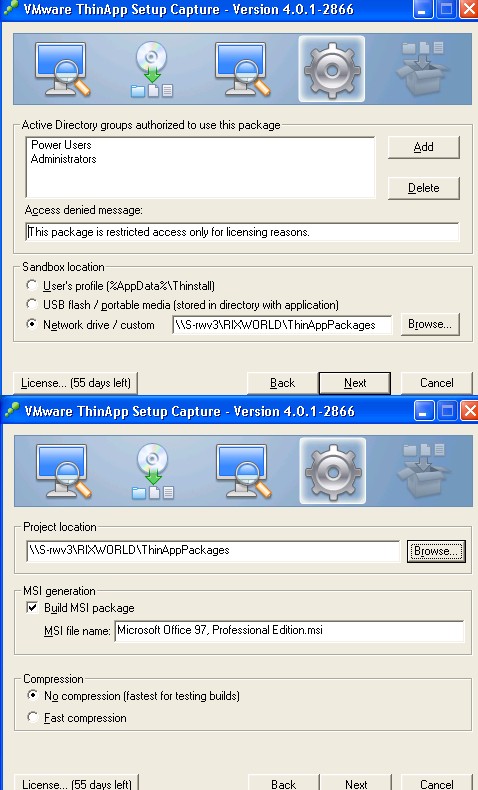

ThinApp packages created by one version of the tool coexist on the same user device with applications packaged by a new version. EXE format, which are encapsulated from other apps and from the underlying machine's operating system.

ThinApp supports all released x86-based Windows systems from Windows NT4, 2000, XP (64/32), Vista (64/32), Server 2003, Server 2008 (64/32), Server 2008 R2 (64/32), and Windows 7 (64/32). VMware ThinApp packages applications into executable files, in. Unlike self-extracting ZIP files, ThinApp does not extract files to disk or require system registry changes in order to run applications.

Also it is able to scan a system before and after an applications installation and create a portable executable based upon changes made to the systems files and registry. msi files into self-contained EXE files which includes everything required to run. NOTE: You will need to remember your initial scan settings. ThinApp converts standard application installers such as. To work around this, simply locate the initial SNAPSHOT file usually located in the account’s TEMP folder although sometimes found in the PROGRAMFILES\VMware\VMware ThinApp\ folder- and run the value from the run window or command line. Sandboxie is a program for Windows that is designed to allow the user to isolate individual programs on the hard drive. ThinApp does not have any pre-installed components and does not require the installation of device drivers allowing applications to run from USB keys or network shares without ever requiring Administrator rights. The best VMware ThinApp alternatives based on verified products, community votes, reviews and other factors. The virtual environment presented to the client is a merged view of the underlying physical and virtual resources, thereby allowing the virtualization layer to fool the application into thinking that it is running as if it were fully installed. ThinApp is able to execute applications without them being installed in the traditional sense by virtualizing resources such as environment variables, files and Windows Registry keys. VMware ThinApp is an application virtualization solution. You will find all the information you need in the online documentation I use all the time.VMware ThinApp (formerly Thinstall) is an application virtualization and portable application creator suite by VMware that can package conventional applications so that they become portable applications. What's good with ThinApp is that you can do everything, you just need to be creative ! (you add the script to the root folder and compile it with the application, so everytime you start the application the script will run and add a line in your tracking licence file. If you want to track the licencing usage of your application, you can create a vbscript that can add an increment line in a file from your shared folder where your application are. This will prevent unauthorize people from running your applications. PermittedGroups=Administrators Remote Desktop UsersĬreate an Active Directory Group for your application. If you want to prevent unauthorise people to use the application, before compiling your application, modify the package.ini file


 0 kommentar(er)
0 kommentar(er)
